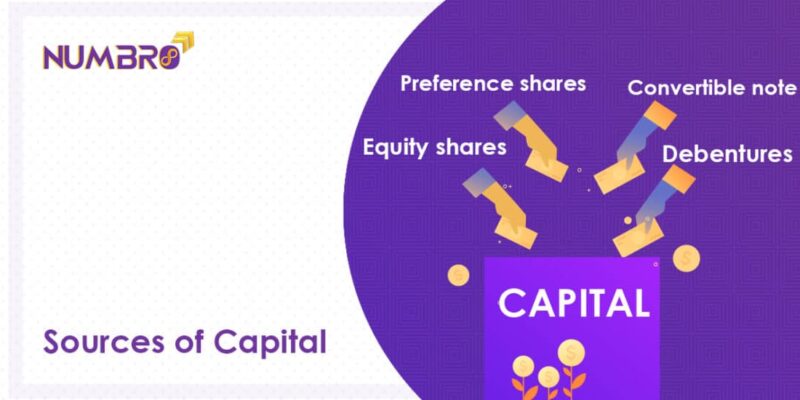What is capital, Features & different types of capital?
Do you understand what is capital ,types of capital and its importance for a business, different sources of financing to begin a business? In this article, we will elucidate the various sources of funds for infusion into the company, along with their significant features.
Startups may dig all their piggy banks and invest in businesses. Such investment of monies into a business venture is known as capital, and it is the main lifeline for the commencement of business and finance into assets.
What is capital?
Capital forms the source of funding for business operations and growth. A company’s finance is from different sources of fund. The owner’s fund termed as equity and borrowed funds termed as debt. A collective name for such sources is called capital structure. A capital structure is a mix of owner’s fund plus borrowed funds.
Determining the investment strategy of using borrowed and owner’s funds is called the financial leverage of the company. The computation of the financial leverage of the company helps to arrive at the optimal debt and equity mix of capital structure in a company. A company having more debt funds has a higher leverage ratio, and it is an aggressive capital structure with higher risk to investors. Yet, the growth is also at a high rate along with the risk in a debt-financed company.
Structure for Different types of capital?
Broadly, a capital structure consists of equity and debt, but these are sub-classified based on their characteristics. The flowing chart provides you with a bird’s eye view of a variety of capital structures.

Features of these sources of Equity in detail
Equity Share Capital:
- Equity share capital is a long-term financing option as it is not redeemable.
- A member purchasing equity share becomes the fractional owner depending on the number of shares possessed.
- Equity shareholders have the right to vote on varied matters, the right to designate key managerial personnel, and a right to participate in management decisions.
- On investment in equity shares, investors bestow upon the right to claim dividends on the surplus profits of the company. Still, there is no obligation upon the company to pay dividends. Dividends declared and paid by the management only in case of extra profits.
- Equity shares are marketable as they are easy to transfer or sell, with or without consideration, in the capital markets
- Equity share capital is a permanent source of funding, and they are repaid only in case of winding up of the company. Even in the case of liquidation, equity shareholders resort at the bottom line in repaying order.
Preference Share Capital:
The foremost characteristics of a preference share are the right to receive dividends and liquidation preference. Unlike in equity shares, the company must pay a dividend to the preference shareholders. Based on the type of preference shares held, the payment of arrears of preference dividend are made, as described as follows:
Cumulative Preference Shares – Preference shares are said to be cumulative in nature when the arrears of dividends are cumulative and paid before paying any of the common stockholders. That is, dividends declared and not paid to accumulate each year and paid when there are surplus profits. Unless stated in memorandum or articles of association, all preference shares are said to be cumulative.
Non-Cumulative Preference Shares – Dividends are payable only out of profits of each year and do not accumulate if not paid. Though the dividends are due for payment, preference shareholders cannot claim such dividends in the later years.
Preference shareholders do not have a right in the share profits of the company as they receive a fixed rate of dividends. But a specific exception exists in this case which are as below:
- Participating Preference Shares – Participating preference shareholders can take part in the balance of profits on par with equity shareholders apart from their fixed rate of dividend on their shares. If such right is expressed in the memorandum or articles of association, shareholders will have the right to share the surplus assets in case of winding up.
- Non-Participating Preference Shares – Persons holding non-participating preference shares are only entitled to a fixed rate of dividend and do not share any surplus profits. Unless stated in memorandum or articles of association, preference shares are deemed to be non-participating preference shares.
As in the case of equity shares, the redemption of preference shares too cannot be done unless stated in specific. Conversion or redemption of few other types of preference shares can be done over some time, as described below:
Compulsorily Convertible Preference Shares – These shares are converted into equity shares within a specified period as stated in terms of issue, memorandum, or articles of association. Usually, the time of conversion depends on the company’s performance. This means the shares get converted into equity shares only after achieving the targeted growth.
- Optionally Convertible Preference Shares – As it is self-explanatory, the option of converting preference shares to equity shares after a pre-determined time are optionally convertible preference shares. The option sustains with the company or the shareholder, or in few cases, it could be a combination of both.
- Redeemable Preference Shares – the issuer company of these preference shares can buy back such stock on or after a specific date. The company may redeem the shares at a payment price stated in the investment. These shares are also known as callable preferred stock.
- Preference shareholders do not confer the right to vote feature and take part in management decisions as they are in an advantageous position compared to the equity shareholders.
- In the event of liquidation, preference shareholders stand afore to the equity shareholders. The company guarantees fixed dividends to preference shareholders in case of profits scenario. Still, if the things turn upside down and the company fails to make profits and shuts down, then compensation of preference shareholders is done with company assets sooner.
Debentures:
- A debenture is document evidence stating the name of issuing company, principle debt amount and interest payable thereon, time of repayment, and the amount payable.
- The issue of debentures does not increase the capital base, and the debenture issue is cheaper compared to the issue of preference or equity shares.
- A debenture holder is like any other creditor to the company where interest is paid whether or not a company makes profits.
- Debenture holders do not carry any right on the assets of the company unless a charge created in case of secured debentures.
- Debenture holders do not carry voting rights and cannot take part in the management affairs.
- Debentures are transferred and sold at any prices in the open market.
- Debentures can be redeemable or convertible based on the type of issue resolved by the company, as explained as follows:
Compulsorily Convertible Debentures (CCDs) – Compulsorily converted debentures are also considered as hybrid instruments. That is, they are treated as debt upto a certain period and then converted into equity shares. Once the CCDs are converted into equity shares, they automatically become shareholders of the company and acquire all the rights that of a shareholder
Optionally Convertible Debentures (OCDs) – Debenture holders of OCDs are given a right to convert debt into equity at a price assured at the time of the issue itself.
Convertible debentures can be wholly or partly convertible. In the case of part conversion, a convertible portion is converted into equity shares at the end of the pre-determined period, and the non-convertible portion is redeemed at the terminus of the period.

* vulputate eu scelerisque sit amet just

* vulputate eu scelerisque sit amet just
Convertible Note:
- These are similar to CCDs, that is, they too are hybrid instruments, primitively structured as debt and converted into equity upon denouement of period pre-determined.
- Convertible notes could be promising because they are cost-saving at the time of original investment but ultimately gives the investors the economic benefits of an equity investment.
- Convertible Notes are an attractive instrument for seed-stage companies to raise funds as the compliance’s compared to equity fund is lower.
- The issue of convertible notes in most cases are with a valuation cap and an automatic conversion price at the maturity date. This favors the risk position of the investor.
Executive Summary:
Differences can be identified in the above-mentioned different stock-based on few criteria. We are providing you with an executive summary of the differences in the stocks based on such criteria:
| S. No | Particulars | Equity Share Capital | Preference Share Capital | Debentures |
| 1 | Forms part of capital base | Yes | Yes | No |
| 2 | Voting rights | Yes | No | No |
| 3 | Participation in management affairs | Yes | No | No |
| 4 | Is there an obligation to pay dividend/ interest? | No | Yes | Yes |
| 5 | Whether they can be transferred? | Yes | No | Yes |
| 6 | Can they be converted into common stock? | No | Yes | Yes |
| 7 | Is redemption of shares available in other than liquidation cases? | No | Yes | Yes |



